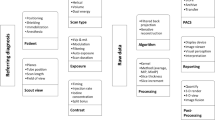Summary
Cebral circulation was investigated by means of rapid sequential scintigraphy (0.5 sec per frame) after intravenous injection of a bolus of 10–15 mCi 99mTechnetium-pertechnetate using a multicrystal gamma camera (Autofluoroscope). The data were stored on a digital tape. Different areas of interest were flagged and time-activity curves were generated from these areas. The clinical significance of different parameters developed from the curves was tested in 70 patients grouped by clinical criteria (32 controls and 38 neurological patients with and without abnormal cerebral circulation). Parameters developed from the first half of the time activity curves were the most informative. In 70% of the neurological patients the result of the brain perfusion study was in keeping with the clinical, angiographic and anatomical findings. False negative results were more frequent than false positive ones.
Zusammenfassung
Es wurde mit Hilfe neuerer technischer Möglichkeiten (Kamerasystem, freie Regionenauswahl) untersucht, inwieweit nach intravenöser Bolusinjektion eines radioaktiven Indicators (10–15 mCi 99mTc Pertechnetat) aus Zeitaktivitätskurven, die mit kurzer Zeitkonstanten (0,5 sec) extern über bestimmten Hirnregionen aufgenommen wurden, vergleichende quantitative Aussagen über Störungen der Hirnzirkulation möglich sind. Hierzu haben wir mehrere Parameter an 70 Patienten für 2 verschiedene Regionen geprüft (32 Kontrollpatienten und 38 nach klinischen Kriterien gruppierte Patienten mit und ohne Störungen der Hirnzirkulation). Den höchsten Informationsgehalt wiesen Parameter auf, die aus der ersten Hälfte der Zeitaktivitätskurve abgeleitet waren. In 70% der Fälle stimmten die Ergebnisse der Hirnperfusionsuntersuchung mit den klinischen, angiographischen und pathologisch anatomischen Befunden überein. Falsch negative Ergebnisse waren häufiger als falsch positive.
Similar content being viewed by others
Literatur
Bender, M. A., Blau, M.: The autofluoroscope. Nucleonics 21, 52 (1963).
Chen, Th., Schmidt, H. A. E.: Qualitative cerebral hemispheric blood flow studies with 113mIn and the Autofluoroscope, dynamic studies with radioisotopes in medicine, I.A.E.A., p. 603. Vienna 1971.
Ingvar, D. H., Lassen, N. A.: Quantitative determination of regional cerebral blood flow in man. Lancet 1961 II, 806.
Jackson, G. L., Blosser, N. M.: Cerebral hemispheric blood flow: Clinical correlation. Int. J. appl. Radiat. 22, 593 (1971).
Marshall, W. H., Lukis, G., Sapirstein, L. A.: Comparison of hemispheric blood flows using a new isotope technetium 99m. Research on the cerebral circulation. Third International Salzburg Conference, S. 121. Springfield: Charles C. Thomas 1969.
McDowall, D. G. (Ed.): Cerebral circulation. Int. Anaesthes. Clinics 7, No. 3 (1969).
Ojemann, R. G., Hoop, B., Brownell, G. L., Shea, W. H.: Extracranial measurement of regional cerebral circulation. J. nucl. Med. 12, 532 (1971).
Oldendorf, W. H.: Clinical applications of brain blood flow studies. Seminars in Nuclear Medicine I, 107 (1971).
Oldendorf, W. H., Kitano, M.: Radioisotope measurement of brain blood turnover time as a clinical index of brain circulation. J. nucl. Med. 8, 570 (1967).
Oldendorf, W. H., Kitano, M., Shimizu, S.: Evaluation of a simple technique for abrupt intravenous injection of radioisotope. J. nucl. Med. 6, 205 (1965).
O'Reilly, Cooper, R. E. M., Ronai, P. M.: Delayed digital perfusion peak: Diagnostik sign of unilateral cerebrovascular disease. J. nucl. Med. 12, 384 (1971), (Abstract).
O'Reilly, Cooper, R. E. M., Ronai, P. M.: Computer selection of regions of interest in digital dynamic studies of cerebral circulation. J. nucl. Med. 12, 384 (1971), (Abstract).
Rösler, H., Huber, P., Hesse, M.: Serienszintigraphische Befunde beim Schlaganfall. Schweiz. med. Wschr. 33, 1401 (1970); 34, 1446 (1970).
Rosenthal, L., Martin, R. H.: Cerebral transit of pertechnetate given intravenously. Radiology 94, 521 (1970).
Sapirstein, L. A.: Measurement of the cephalic and cerebral blood flow fractions of the cardiac output in man. J. clin. Invest. 41, 1429 (1962).
Sapirstein, L. A., Moses, L. E.: Cerebral and cephalic blood flow in man: Basic considerations of the indicator-fractionation technique. In: Kniseley, R. M., Tauxe, W. N. (ed.), Dynamic clinical studies with radioisotopes. U.S. atomic Energy Commission, TID 678, 135 (1964).
World Health Organisation: Cerebrovascular diseases: Prevention, treatment and rehabilitation. Technical report series No. 469 (1971).
Author information
Authors and Affiliations
Additional information
Auszugsweise vorgetragen auf der Tagung der „World Federation of Nuclear Medicine and Biology“, Los Angeles, Juli 1971.
Rights and permissions
About this article
Cite this article
Emrich, D., Breitschuh, H., Hesch, R.D. et al. Quantitative Untersuchungen der regionalen Hirnperfusion mit 99mTechnetium Pertechnetat. Z. Neurol. 203, 51–64 (1972). https://doi.org/10.1007/BF00316078
Received:
Issue Date:
DOI: https://doi.org/10.1007/BF00316078




